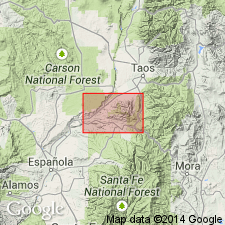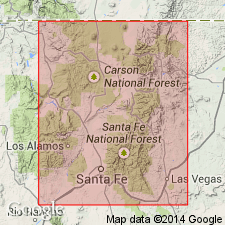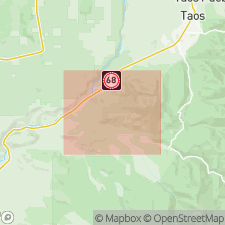
- Usage in publication:
-
- Pilar phyllite member
- Modifications:
-
- Original reference
- Dominant lithology:
-
- Phyllite
- AAPG geologic province:
-
- Southern Rocky Mountain region
Summary:
Pg. 8 (fig. 2), 19-21, pl. 1. Pilar phyllite member of Ortega formation. Name proposed to replace Hondo slate because the latter name had been applied to other rocks prior to Just's usage. The rock is dense, homogeneous, and hard, and is gray-black to black in color, with a gray sheen on cleavage surfaces. Has irregular slaty cleavage. Minimum thickness appears to be 2,300 feet in Picuris Range. Overlies Rinconada schist member and underlies Vadito formation. Age is Precambrian.
Named from village of Pilar, situated at north-central border of [Picuris Mountains] at a point several mi east and north of prominent outcrops of phyllite. Occurs in 2 main east-west belts of 0.5 mi width that extend from upper Hondo Canyon to Piedra Lumbre Canyon, and thence offset to the south to continue as a single, westward tapering belt; [Picuris Mountains], Taos Co., [Carson National Forest area], central northern NM.
Source: US geologic names lexicon (USGS Bull. 1200, p. 3018).

- Usage in publication:
-
- Pilar Formation
- Modifications:
-
- Principal reference
- Revised
- AAPG geologic province:
-
- Southern Rocky Mountain region
Summary:
Pg. 46 (table 1), 50-51. Pilar Formation of Hondo Group. Recognized in the Picuris Mountains of central northern New Mexico. Lies below Piedra Lumbre Formation and above Rinconada Formation (both of Hondo Group). Age is considered Early Proterozoic, younger than 1,700 Ma.
Principal reference section (Hondo Group): Hondo Canyon area, in secs. 29 and 32, T. 24 N., R. 12 E., Taos SW 7.5-min quadrangle, Taos Co., northern Picuris Mountains, [Carson National Forest area], central northern NM.
Source: Publication.

- Usage in publication:
-
- Pilar Formation
- Modifications:
-
- Age modified
- Geochronologic dating
- AAPG geologic province:
-
- Southern Rocky Mountain region
Summary:
Pg. 1424-1425, 1429 (fig. 5), 1430-1431, 1432; C.G. Daniel and others, 2013, GSA Field Guide 33, p. 205-235. Pilar Formation of Hondo Group. A distinctive, fine-grained, black, carbonaceous phyllite or schist with cm- to m-scale, metamorphosed tuff layers (=white schistose layers of Long, 1976; Bauer, 1988). Estimated maximum thickness about 600 m. Gradationally underlies Piedra Lumbre Formation of Hondo Group. Disconformably(?) overlies Rinconada Formation of Hondo Group. Age is Mesoproterozoic; a metamorphosed tuff layer in upper part of the Pilar is 1,488 +/-6 Ma.
[On p. 1429 (fig. 5), and p. 1432-1433, authors included the Piedra Lumbre and Pilar Formations in their informal Trampas group.]
Source: Publication.
For more information, please contact Nancy Stamm, Geologic Names Committee Secretary.
Asterisk (*) indicates published by U.S. Geological Survey authors.
"No current usage" (†) implies that a name has been abandoned or has fallen into disuse. Former usage and, if known, replacement name given in parentheses ( ).
Slash (/) indicates name conflicts with nomenclatural guidelines (CSN, 1933; ACSN, 1961, 1970; NACSN, 1983, 2005, 2021). May be explained within brackets ([ ]).

